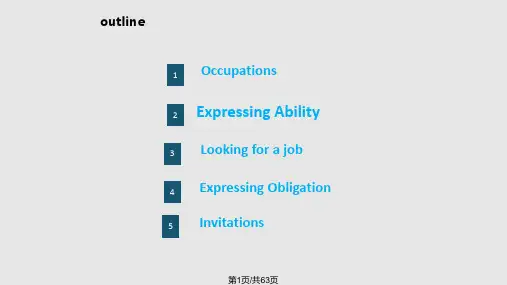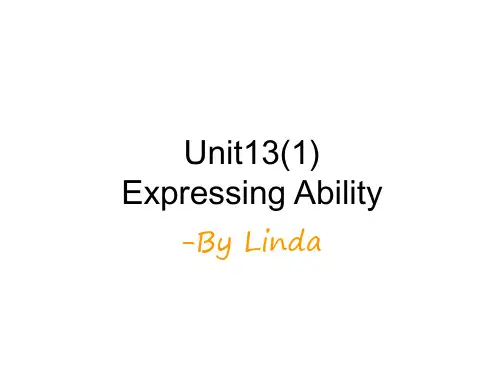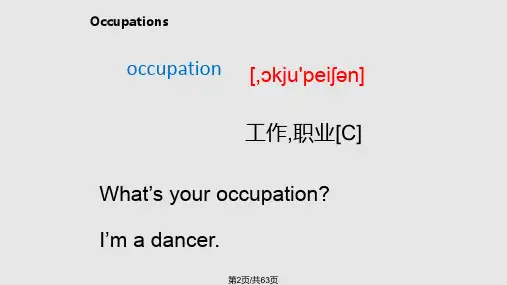SBS朗文国际英语教程第1册-教师用书
- 格式:pdf
- 大小:4.14 MB
- 文档页数:14





![2024版SBS朗文国际教程[1]](https://uimg.taocdn.com/94cf2557a66e58fafab069dc5022aaea998f41d1.webp)



朗文国际英语教程教师用书
《朗文国际英语教程教师用书》是《朗文国际英语教程》的配套教师用书,每个单元提供详细的课文讲解,包括词汇、语法、发音和练习答案等,还提供每个单元的主题词汇、功能表达、课堂活动和扩展练习等内容,方便教师进行教学设计和课堂组织。
此外,教师用书还提供每个单元的听力材料和听力答案,方便教师进行听力训练和听力测试。
总之,《朗文国际英语教程教师用书》是一本非常实用的教师用书,可以帮助教师更好地理解和教授《朗文国际英语教程》,提高教学质量和学生的学习效果。
1。
FUNCTIONSA SKINGFOR ANDR EPORTING I NFORMATIONWhat’s your name?My name is Maria .What’s your first name?Sarah .What’s your last name?Kelly .How do you spell that?K-E-L-L-Y .What’s your address?My address is 235 Main Street .What’s your phone number?My phone number is 741-8906.Where are you from?I’m from Mexico City .I’m American.My license number is 921DCG .My apartment number is 4-B .My social security number is 044-35-9862.My e-mail address isTeacherJoe@.M EETING P EOPLE Hello.Hi.My name is _______.I’m _______.Nice to meet you.Nice to meet you,too.T O B EGRAMMARNEW VOCABULARYPeopleactoractressAmericanathleteMr.Mrs.Ms.presidentprime ministerPlacesBrooklynFloridaMexico CityNew YorkSan FranciscocountryPersonal Information addressapartmentapartment numbere-mail addressfax numberfirst namelast namelicense numbernamenumberphone numbersocial security number streettelephone number Cardinal Numbers0oh (zero)1one2two3three4four5five6six7seven8eight9nine10tenArticlesathePossessive AdjectivesmyyourPrepositionsfromofQuestion WordsWhatWhereSubject PronounsIyouVerbsareisam (’m)EXPRESSIONSHello.Hi.Nice to meet you.Nice to meet you,too.CLOSE UP•To Be:IntroductionFOCUS1.Teach the first question and answer in the conversation before students open their books.(What’s your name? My name is _______.)a.Begin by saying your name:“My name is _______.”b.Then ask individual students:“What’s your name?”Students answer:“My name is ________.”c.Next,have individual students ask each other.2.If you haven’t already introduced thenumbers 0–10,refer to the teaching steps on page 4 of this Teacher’s Guide.(Be sure to tell students that in telephone numbers,people usually say “oh”rather than “zero.”Have students repeat “Oh.”)3.Practice the numbers.a.Write the numbers 0–10 on the board or use flash cards.Point to numbers at random and have the class say them.b.Continue with individual students.1.Have students look at the model illustration.2.Set the scene:“A teacher and student are talking.”3.With books closed,have students listen as you present the model or play the audio one or more times.4.Full-Class Repetition:Model eachquestion and answer in the dialog and have students repeat.5.Have students open their books and look at the dialog.Ask students if they have any questions.Check understanding of vocabulary .6.Group Choral Repetition:Divide the class in half.Model the 1st question of the dialog and have Group 1 repeat;model the answer and have Group 2 repeat.Continue this way with the other questions and answers in the dialog.7.Choral Conversation:Groups 1 and 2practice the dialog twice,without teacher model.First,Group 1 asks the questions and Group 2 gives the answers;then reverse.8.Call on one or two pairs of students to present the dialog.(For additional practice,do ChoralConversation in small groups or by rows.)INTRODUCING THE MODELGETTING READYPronunciation NoteThe pronunciation focus of Chapter 1 isLinked Sounds(text page 6).You maywish to model this pronunciation at thispoint and encourage students to incorporateit into their language practice.Students use the questions of the model to give their own names,addresses,and phone numbers,and tell where they are from.1.Call on a few pairs of students to ask andanswer the questions,using informationabout themselves in the answers.2.Divide the class into pairs,and have thepairs ask and answer the questions.Thencall on pairs of students to present theirdialogs to the class.Note that the numbers in students’ addresses may be higher than the ones they havelearned.For this exercise you can havestudents read each digit in their addresses.For example,232 might be read as two,three, two rather than two thirty-two.(Highernumbers will be taught in Chapter 5.)Pages 2–4,Exercises A–DWORKBOOKANSWER THESE QUESTIONSThis is a role-play exercise that reviews the questions on text page 2.Students pretend to be famous celebrities who are being interviewed on television.One student is the interviewer and asks the questions.Another pretends to be the famous person.Talk shows are popular in the United States and usually feature a well-known host talking with famous people.1.Have students think of famous people in the categories suggested on text page 3.If they have difficulty ,make some suggestions.You can use magazine and newspaperphotographs as cues.The students can assume the role of the celebrity in the photograph.2.Have pairs of students practice and then role-play their interviews in front of the class,making up addresses and phone numbers for the famous people.1.Have students look at the illustration.2.Set the scene:“Two people are meeting each other.”3.With books closed,have students listen as you present the conversation or play the audio one or more times.4.Full-Class Repetition:Model each line and have students repeat.5.Have students open their books and look at the dialog.Ask students if they have any questions.Check understanding of new vocabulary:Hello;Hi;Nice to meet you;Nice to meet you,too.6.Group Choral Repetition:Divide the class in half.Model line A and have Group 1 repeat;model line B and have Group 2repeat.7.Choral Conversation:Groups 1 and 2practice the dialog twice,without teacher model.First Group 1 is Speaker A and Group 2 is Speaker B;then reverse.8.Call on one or two pairs of students to present the dialog.9.Have students walk around the classroom,introducing themselves to each other.10.Call on several pairs of students to presenttheir conversations to the class.Meeting People:In the United States,it is common to initiate a conversation with self-introduction (Hello.My name is ...,Hi.I’m ...).“Hello”and “Hi”are equally common ways to greet people.“Hi”is moreinformal than “Hello.”READINGThis exercise is based on the reading on text page 4.Listen and choose the correct answer.1. A.What’s your name?B.Mary Black.2. A.What’s your address?B.Two sixty-five Main Street.3. A.What’s your apartment number?B.FiveC.4. A.What’s your telephone number?B.Two five nine–four oh eight seven.5. A.What’s your social security number?B.Oh three two–eight nine–six one sevennine.6. A.What’s your e-mail address?B.maryb-at-worldnet-dot-com.Answers1.a 4.b2.b 5.b3.a6.aIf you haven’t already introduced the alphabet,refer to the teaching steps on page 4 of this Teacher’s Guide.1.Have students look at the illustration.2.Set the scene:“A person is interviewing someone.”3.With books closed,have students listen as you present the conversation or play the audio one or more times.4.Full-Class Repetition:Model each line and have students repeat.5.Have students open their books and look atthe dialog.Ask students if they have any questions.Check understanding of new vocabulary:last name,first name,How do you spell that?6.Group Choral Repetition:Divide theclass in half.Model line A and have Group 1repeat;model line B and have Group 2repeat.7.Choral Conversation:Groups 1 and 2practice the dialog twice,without teacher model.First Group 1 is Speaker A and Group 2 is Speaker B;then reverse.8.Call on one or two pairs of students topresent the dialog.9.Have students walk around the classroomand interview five other students,asking and answering the questions in the model conversation as they complete the chart.10.Follow up by asking students to read aloudthe names of the students they interviewed.Pages 4–5 Exercises E–HWORKBOOKINTRODUCE THE CONVERSATIONGETTING READYFocus on ListeningPractice the sentences in the left column.Say each sentence or play the audio one or more times.Have students listen carefully and repeat.Focus on PronunciationPractice the sentences in the right column.Have students say each sentence and then listen carefully as you say it or play the audio.If you wish,have students continue practicing the sentences to improve their pronunciation.Have students write their journal entries at home or in class.They can share their written work with other students if appropriate.As a class,in pairs,or in small groups,have students discuss what they have written.Have students keep a journal of their written work.If time permits,you may want to write a response in each student’s journal,sharing your own opinions and experiences as well asreacting to what the student has written.If you are keeping portfolios of students’ work,these compositions serve as excellent examples of students’ progress in learning English.1.Divide the class into pairs or small groups.2.Have students take turns reading the sentences in the grammar boxes.Have students ask you any questions about the meaning or pronunciation of the vocabulary .If students ask for the pronunciation,repeat after the student until the student is satisfied with his or her pronunciation.KEY VOCABULARYGRAMMARLinked Sounds:Final consonants are often linked to beginning vowel sounds in the word that follows.A.WHAT ARE THEY SAYING?1.What’s,name 2.address,My ,is3.your,phone number4.your,name5.What’s,address6.phone,My ,number7.Where are,I’m from/ADDRESS/PHONE NUMBER (Answers will vary.)C.LISTENINGListen and circle the number you hear.1.My address is five Main Street.2.My address is seven Main Street.3.My address is two Main Street.4.My address is six Main Street.5.My address is one Main Street.6.My address is three Main Street.7.My address is four Main Street.8.My address is eight Main Street.9.My address is ten Main Street.10.My address is nine Main Street.Answers 1.5 6.32.77.43.28.84.69.105.110.9D.NUMBERS 4six 7two 1seven 8three 10one 2eight 9ten 6four 5nine 3fiveE.LISTENINGListen and write the missing numbers.1. A.What’s your phone number?B.My phone number is 389-7932.2. A.What’s your telephone number?B.My telephone number is 837-2953.3. A.What’s your apartment number?B.My apartment number is 6-B.4. A.What’s your address?B.My address is 10 Main Street.5. A.What’s your fax number?B.My fax number is 654-7315.6. A.What’s your license number?B.My license number is 2613498.Answers 1.2 2.53.6 4.105.7,36.1,4,8F.LISTENINGListen and write the missing letters.1. A.What’s your last name?B.Carter.A.How do you spell that?B.C-A-R-T-E-R.2. A.What’s your last name?B.Johnson.A.How do you spell that?B.J-O-H-N-S-O-N.3. A.What’s your first name?B.Gerald.A.How do you spell that?B.G-E-R-A-L-D.4. A.What’s your last name?B.Anderson.A.How do you spell that?B.A-N-D-E-R-S-O-N.5. A.What’s your first name?B.Phillip.A.How do you spell that?B.P-H-I-L-L-I-P .6. A.What’s your last name?B.Martinez.A.How do you spell that?B.M-A-R-T-I-N-E-Z.WORKBOOK PAGE 5WORKBOOK PAGE 4WORKBOOK PAGE 3WORKBOOK PAGE 2Answers1.R,E 4.R,O2.H,S,N 5.P,L3.G,A,D 6.M,T,ZG.WHAT ARE THEY SAYING?7.is2.Hi8.Hello3.meet9.I’m4.Nice 10.to5.you11.you6.My。